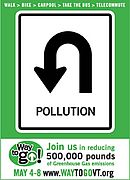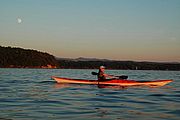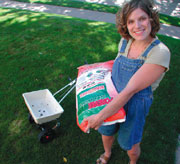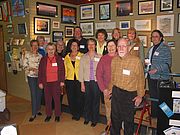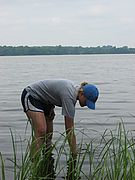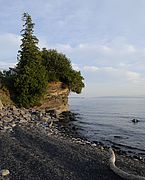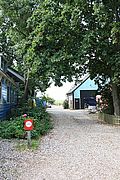On May 4-8, leave your car at home and join the fun!
Way to Go is an annual program co-founded by LCC to promote the use of cheaper, healthier, more earth-friendly alternatives to driving alone. Individuals, businesses, schools, organizations can all easily participate. Just pledge to get to work, school or play by walking, biking, carpooling, taking the bus or telecommuting at least one day in May. Sign up online and your pollution, gas and money savings will be calculated and you'll be entered into a drawing for great prizes – iPods, cordless electric mowers, snowboards, overnight stays, bus passes, and gift certificates! Whether you live in the Lake Champlain Basin year-round or just visit here occasionally, we hope you'll join in the event.
Read...
Reserve your copy by joining LCC or renewing your membership.
The 2009 Quadricentennial edition of the Lake Champlain Paddlers' Trail Guidebook and Stewardship Manual will be out in June. It includes Trail descriptions and chartlets, launch site locations, natural and cultural history articles and equipment check lists. - And it's available to all members who renew annually for $40 or more.
Read...
The spring weather has many of us poring over seed catalogues and hankering to get out gardening. Here are a few "clean lake" tips to follow to ensure that the investments you make in your property stay there rather than running off into the lake:
Don't apply fertilizer in the spring. Early fall is the best time to fertilize in the Champlain Valley. So hold off on adding anything to your soil now and use the time instead to get a soil test done so you know what - if anything your soil needs. Contact Cornell Cooperative Extension in New York and UVM Extension in Vermont to obtain soil test kits.
Don't use fertilizer with phosphorus. Studies indicate that the majority of northeastern lawns have more than enough phosphorus. If you do use fertilizer, make sure to buy a bag of the phosphorus free stuff. The three numbers on the fertilizer bag indicate the Nitrogen (N), Phosphorus (P), and Potassium (K) content. A "zero" in the middle means it is phosphorus-free. Lawns rarely need extra potassium (K) but adding some won't affect water quality.
Plant grass seed on existing lawns in the fall and spring. Use a grass mixture that does well in the area and leave legumes, such as common white clover, among the grass to add nitrogen to your lawn naturally. These practices will encourage strong root growth and enable the grass to outcompete weeds.
Mow to maintain a height of 3 to 4 inches. Cut off no more than 1/3 of the grass blade and leave the clippings on the lawn to add nutrients and organic matter.
Sweep any clippings and fertilizer off paved or hard surface areas. This will keep nutrients on your land instead of in the lake. Read...
On April 2nd Phoenix Books and Café played host to a celebration of Lake Champlain in words and pictures attended by about sixty people. The event was a collaboration between LCC, the bookstore and the Essex Art League. Lake paintings by over 20 artists, poetry by award-winning author Daniel Lusk, and natural history from LCC’s roving scientist Mike Winslow were served up with delicious refreshments. If you missed the opening, you can still view the lake art at Phoenix Books until the end of May. If you have an idea for a lake program you’d like to organize in your community, please get in touch with us at lcc@ lakechamplaincommittee.org. Read...
LCC is gearing up for another monitoring season and are in search of blue green algae monitors for St. Albans Bay and possibly Missisquoi Bay. These locations often have the highest density of algae blooms, so they’re important to maintain. We may need additional volunteers later in the year so please stay tuned. LCC will provide sampling equipment, training, and ongoing support. Willing volunteers need to be able to take water samples between 10AM and 2PM on Sundays or Mondays between June 30th and September 1st and deliver them to a designated drop-off location. Samples are taken in very shallow water, so a boat is not necessary as long as the volunteer has access to the shore. If you’re interested, please contact LCC Staff Scientist Mike Winslow at 802-658-1461 or mikew@lakechamplaincommittee.org. Thanks! Read...
We have a whole series of lake lectures, natural history discussions and outings planned for spring and summer. Click on the title above to see what’s happening in May or check out the LEARN section of our website for upcoming events and other lake information. If you’d like to schedule a presentation about the lake for your community, please contact us at lcc@lakechamplaincommittee.org.
If you’re unable to attend any of our programs, you can easily add to your lake knowledge by purchasing “Lake Champlain: A Natural History” from our secure online store. The 160-page publication covers the lake’s geology, geography, biology and ecology in an accessible, engaging style.
Read...
Early spring to mid-summer offers opportunities for observing spawning behavior in many of the small common fish species of Lake Champlain. There are about 28 minnow species that occupy the lake ranging from tiny shiner species that rarely get more than 2.5 inches long to the common carp which may grow up to 25 pounds. Each species has distinctive habits and behaviors. Read...
Driveways are a defining characteristic of many suburban neighborhoods. They have the simple utilitarian task of providing a transport route or storage place for our vehicles. Some can host basketball games or chats with neighbors. Due to their prevalence they comprise a significant portion of the developed landscape and therefore, can have an impact on water quality.
There are three ways the water from driveways can pollute streams. First, while traveling over the driveway the water picks up any oil, antifreeze, leaves or litter left there, carrying it to streams. Second, during rainstorms driveways, like all impervious surfaces, shed water that would otherwise be absorbed and filtered by soils. As a result more water enters storm drains and flows directly to streams where it causes erosion. Third, the material used to coat driveways can erode and cause pollution. Many driveways are coated with coal tar-based sealants. Coal tars are a by-product of the production of coal coke, distilled coal used as fuel and in iron ore smelting. Many contaminants are released in the erosion and breakdown of coal tars, most notably polycyclic aromatic hydrocarbons (PAHs), many of which are suspected human carcinogens and toxic to aquatic life.
Read...

